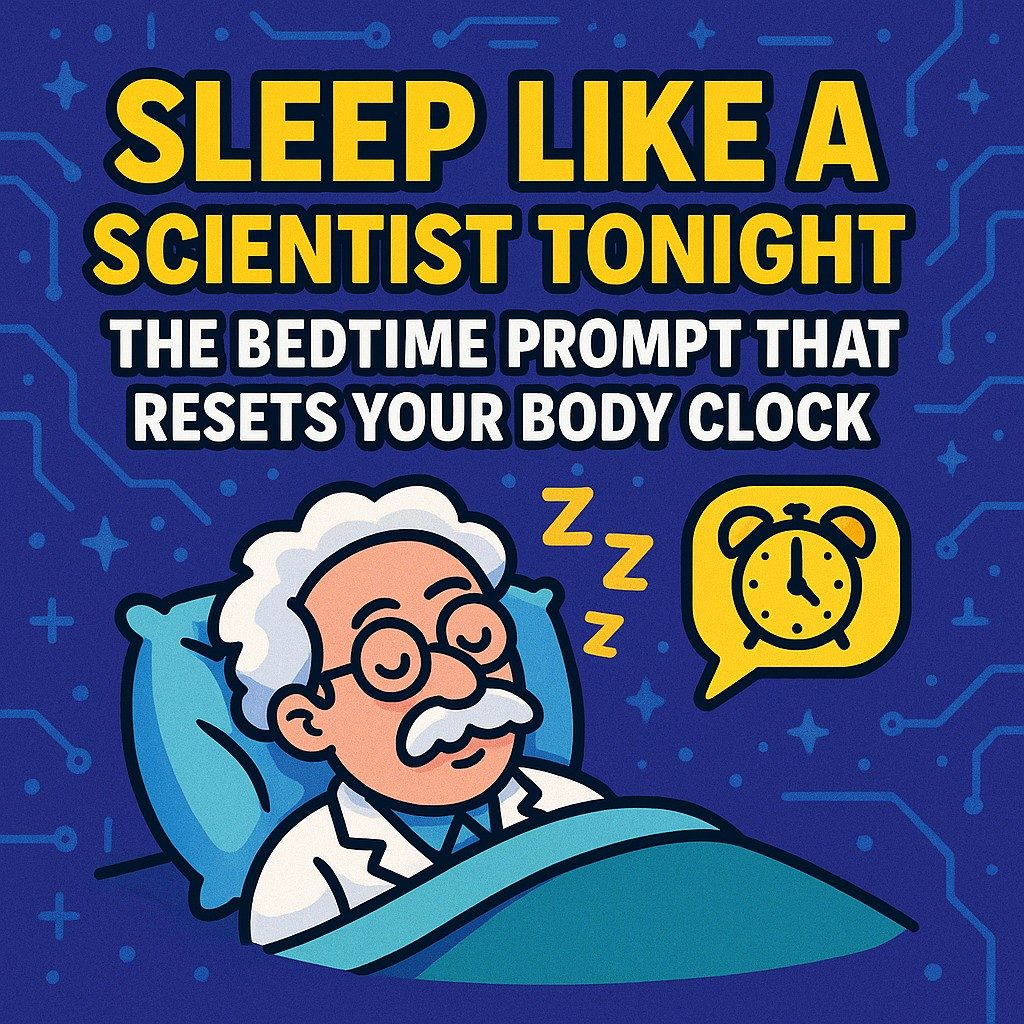Views: 0

Ever lain in bed staring at the ceiling clock, willing your brain to switch off? You’re not alone. Modern life bombards us with blue light, erratic schedules, and constant stimulation, hijacking our natural sleep–wake cycle. But you can reclaim restorative rest tonight with a simple, science-backed bedtime prompt designed to reset your body clock. Read on to discover how to transform ChatGPT into your personal sleep coach—and drift off like a pro.
Why Your Body Clock Needs a Reboot
Your circadian rhythm is your internal timekeeper, signaling when to wake, eat, and sleep. When it’s disrupted, every night becomes a wrestling match with insomnia and groggy mornings.
- Blue light overload from screens after sunset delays melatonin release, making it hard to feel sleepy.
- Late caffeine or stress can spike cortisol levels just as you’re trying to unwind.
- Inconsistent schedules, especially on weekends, confuse your brain’s “sleep or wake” signals.
- Result: Tossing, turning, and waking less refreshed than when you first lay down.
Meet Your Digital Sleep Coach
Imagine having a tailored wind-down plan in your pocket—one that accounts for your habits, environment, and goals. That’s exactly what the bedtime prompt does: it asks ChatGPT to analyze your evening routine and return a time-stamped, step-by-step sleep like a scientist protocol. You’ll receive:
- A personalized relaxation sequence
- Science-backed tips to synchronize your circadian rhythm
- A calming bedtime routine checklist you can follow immediately
The Ultimate ChatGPT Prompt
Engage the AI with this simple command before your nightly scroll:
“Hey ChatGPT, I want to sleep like a scientist tonight. Here’s my current evening routine: [e.g., ‘scroll social media at 10 pm, drink coffee at 6 pm, workout at 8 pm’]. I aim to fall asleep by 11 pm and wake refreshed at 6 am. Create a step-by-step bedtime routine with timings, relaxation exercises, and light recommendations to reset my body clock. Explain why each step helps balance my circadian rhythm.”
Feel free to swap in your actual schedule. The more precise your details, the better your body clock reset plan will be.
How It Works: Science Meets Simplicity
- Contextual Awareness: ChatGPT pinpoints sleep disruptors—like late caffeine or screen time—and flags them.
- Timed Interventions: Research shows dimming lights 60–90 minutes before bed, cooling your room to around 65 °F, and using breathwork all boost melatonin and lower cortisol.
- Actionable Steps: Instead of vague advice, you’ll get clear cues (“At 9:00 pm, switch to warm lighting; at 9:15 pm, practice box breathing for five minutes”).
- Educational Rationale: Each recommendation comes with a brief explanation, so you understand how it resets your body clock.
Step-by-Step: Implement Your Lab-Grade Bedtime Routine
- Review Your Schedule: Confirm the AI’s 60– to 90-minute wind-down timeline.
- Set Reminders: Use your phone or smart speaker to announce prompts like “Begin warm-light phase” or “Start relaxing breaths.”
- Optimize Your Environment: Adjust room temperature (~65 °F/18 °C), minimize noise, and switch off bright screens.
- Complete Relaxation Exercises: Follow guided techniques—progressive muscle relaxation, box breathing, or guided imagery.
- Lights Out: Power down devices, settle into bed, and let your reset body clock routine take over.

Shredded Memory Foam Pillows for Sleeping,Bed Pillows Queen Size Set of 2 Pack Cooling Adjustable,Good for Side and Back Sleeper with Washable Removable Cover
Pro Tips for Maximum Zzz’s
- Consistency Is Key: Run the same prompt nightly for at least one week to train your circadian rhythm.
- Track Your Sleep: Log your sleep latency and quality in a journal or app to fine-tune your plan.
- Customize Details: Share preferences like preferred ambient sounds or breathing patterns to refine AI feedback.
- Pre-Bed Diet: Avoid heavy meals and alcohol two hours before bedtime—ask ChatGPT to include this reminder.
- Morning Light Exposure: A brief morning sun session helps reinforce your wake cycle; include it in your routine.
Common Pitfalls & How to Avoid Them
Screen Overreliance: Copy the plan and stash your phone out of reach to prevent another scrolling session.
Privacy Concerns: If you’d rather not share specific habits, generalize your routine and still get effective guidance.
One-Size-Fits-None: Adjust timings and activities based on your own sleep logs—your body is the final authority.
Overcomplication: Stick to the core steps first; add more nuances only after you’ve mastered the basics.
Real-Life Success Story
Sarah, a graphic designer, swapped her midnight TikTok marathon for a 9 pm warm-light wind-down and box breathing at 9:30 pm. Within three nights, she fell asleep 20 minutes faster and woke without groggy fog. A month later, her average REM duration increased by 25%, fueling sharper focus and creativity at work. Her transformation shows how a simple bedtime prompt can turn restless nights into rejuvenating rest.
Building a Sustainable Sleep Habit
- Weekly Check-Ins: Refresh your AI prompt for weekend schedules or travel adjustments.
- Monthly Reviews: Compare sleep logs to tweak your routine—maybe you need extra stretching or a different wake-time recommendation.
- Community Sharing: Trade successful prompt hacks with friends or online sleep forums to uncover new strategies.
Treat your sleep like a scientist protocol as a living document, one that evolves with your lifestyle and keeps your circadian rhythm in harmony.
Your brain spends roughly one-third of its life asleep—give it the VIP treatment it deserves. With this personalized bedtime prompt and science-backed routine, you’ll reset your body clock tonight and every night. Skip the sheep counting; embrace the AI-driven sleep revolution and wake up with energy to conquer your day.
Try it tonight and let us know how many minutes you shaved off your sleep latency in the comments below!

